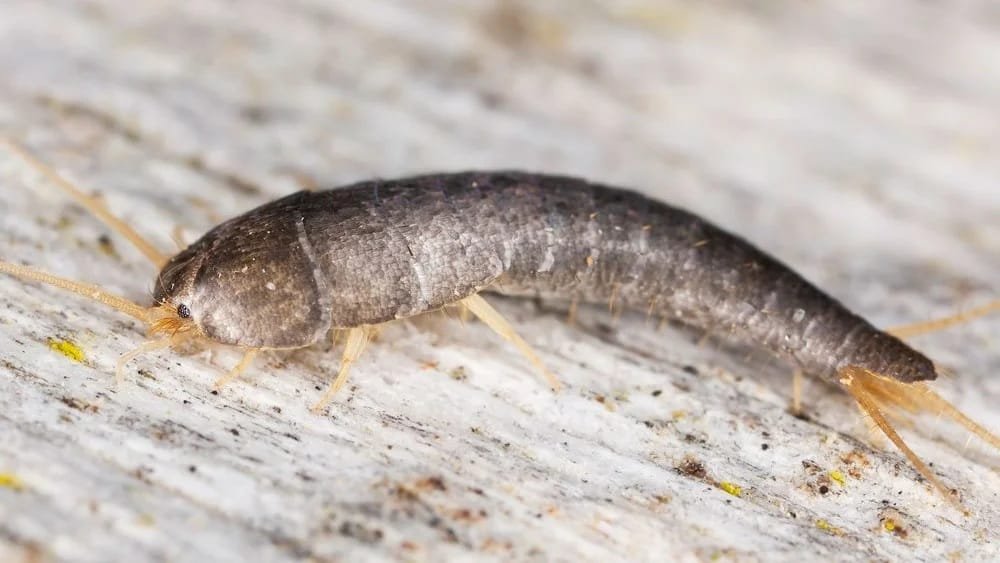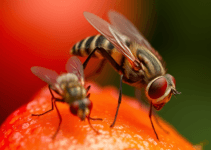Discover how to effectively manage silverfish infestations in your home with practical tips and strategies. Learn about keeping humidity levels low, decluttering, sealing entry points, and utilizing natural repellents. Early detection is crucial in preventing significant damage. Our comprehensive guide provides insights on identifying silverfish, their habits, and when to seek professional help. Reclaim your space and protect your belongings from these pesky pests!
Understanding Silverfish: The Sneaky Little Pests
Silverfish, scientifically known as Lepisma saccharina, are small, wingless insects that have a distinctive teardrop shape and silvery-blue coloration, which gives them their name. These pests are typically 1/2 to 1 inch long and are characterized by their long antennae and three long bristles on their rear. Silverfish are nocturnal creatures, preferring to remain hidden in dark, damp corners of homes, which often makes their presence unnoticed until a significant infestation occurs.

The diet of silverfish is primarily composed of carbohydrates, specifically starches and sugars, which are commonly present in household items such as paper, glue, books, and even human food. It is this voracious appetite that poses a threat to the integrity of household items, making it essential to understand their habits and behaviors. Silverfish thrive in environments with high humidity, so areas such as bathrooms, kitchens, and basements are particularly susceptible to their invasion.
Read this article and do not forget to check our YouTube channel “Grig Stamate” for other amazing videos:
https://www.youtube.com/@GrigStamate
House Tours, #13 – Family Homes with Comfortable Interiors (video)
Signs of a silverfish infestation may include the discovery of small holes in paper products or fabric, yellowish stains on surfaces, or the presence of cast skins, which are the exoskeletons they shed as they grow. Homeowners may also notice a metallic scent or find silverfish scuttling across surfaces, particularly during the night. Many have shared humorous anecdotes about encountering these sneaky pests unexpectedly, often expressing shock at their rapid movements and peculiar appearance. Understanding the habits, diet, and identification signs of silverfish is crucial in establishing effective preventative measures and devising a plan to combat their presence.
Tip 1: Keep Your Home Dry and Humid-Free
Silverfish thrive in environments with high humidity levels, often found in bathrooms, kitchens, and basements. Thus, maintaining a dry atmosphere in your home is crucial to deter these pests. One of the most effective methods to achieve this is by using dehumidifiers, particularly in areas that typically retain moisture. These devices help regulate humidity levels, ideally keeping them below 50%. By incorporating a dehumidifier, you can significantly reduce the habitat suitable for silverfish.
In addition to dehumidifiers, proper ventilation plays a vital role in controlling moisture in your home. Ensure that bathrooms and kitchens are well-ventilated. Utilize exhaust fans while cooking or showering to expel excess moisture to the outside. It’s also beneficial to open windows whenever possible, allowing fresh air to circulate and reducing humidity levels indoors. This simple practice can effectively disrupt the favorable conditions for silverfish to thrive.
Another practical home trick is to check for leaks and water damage, which can promote moisture buildup. Regularly inspect areas such as under sinks, around water heaters, and pipes for any signs of leaks. If you identify any, prompt repairs are necessary to eliminate potential water sources for silverfish. Additionally, consider using moisture-absorbing materials like silica gel or baking soda in areas susceptible to dampness.
Implementing these strategies can make a significant difference in your home’s humidity levels, subsequently lowering the likelihood of silverfish infestations. Though it may require some alterations to your routine, maintaining a dry environment is a proactive step toward creating an unwelcoming space for these pests.
Tip 2: Decluttering is Key
Silverfish are notorious for thriving in cluttered environments, where they find ample hiding spots and a plentiful supply of organic matter for sustenance. The first step to effectively combat these pests is to assess and implement a systematic decluttering strategy in your home. By doing so, not only will you reduce potential silverfish habitats, but you’ll also create a more organized and visually appealing living space.
The act of decluttering can be both liberating and practical. Start by identifying areas in your home that tend to accumulate unnecessary items, such as garages, basements, and closets. These spaces, often left untouched for extended periods, serve as prime locations for silverfish to settle. As you embark on this decluttering journey, ask yourself if each item is necessary or brings you joy. If not, consider donating, recycling, or disposing of them responsibly.
Establishing a regular decluttering routine can significantly diminish the risk of silverfish infestations. Begin with small, manageable sections of your home instead of attempting a complete overhaul all at once. This approach will make the process less overwhelming and more likely to be sustained over time. Embrace the idea of a tidy living space, where every item has a designated place. Doing so not only reduces clutter but also makes cleaning more efficient, further discouraging silverfish from finding a home in your residence.
Additionally, using storage solutions can be a game-changer. Opt for airtight containers to store seasonal clothing, paper products, or out-of-season decor, as they will make it difficult for silverfish to access potential food sources. By rethinking how you manage your belongings, you create an environment that is less welcoming to pests and more enjoyable to live in. Taking the time to declutter not only hinders silverfish but also promotes a calm and organized atmosphere that benefits all aspects of your life.
Tip 3: Seal Up Cracks and Crevices
Silverfish are crafty little pests, known for their ability to squeeze through the smallest of openings. To effectively combat these unwelcome visitors, it is crucial to identify and seal potential entry points throughout your home. Start by examining areas such as windows, doors, and the foundations of your house. Look for cracks and crevices that may provide a pathway for these insects to invade. The older your home, the more likely it is that you will find such gaps.
Common household areas where gaps tend to occur include corners of baseboards, around plumbing fixtures, and the joints where walls meet ceilings. Pay close attention to the areas behind appliances like washing machines and refrigerators, as these can be prime hiding spots for silverfish. A thorough inspection is key to keeping your home pest-free.
Once you have identified these openings, sealing them becomes a priority. Caulk and expanding foam are your best allies for this task; they can provide an effective barrier against silverfish. Just a tip from experience: remember to choose the right caulk! My first attempt involved a quick trip to the hardware store, and let’s just say that my choice didn’t quite adhere as expected—turns out, not all caulk is created equal. It ended up being a gooey disaster that left me with a sticky mess, rather than a sealed home. Consider this a learning experience!
DIY projects can often come with their share of mishaps, but the satisfaction of conquering those little gaps far outweighs any initial hurdles. With a bit of patience and the right materials, you can effectively seal these entry points, dramatically reducing the chances of a silverfish invasion. Regularly checking and maintaining these seals will help in preventing future infestations, ensuring a clean and pest-free living space.
Tip 4: Smart Storage Solutions
Effective storage solutions play a pivotal role in preventing silverfish infestations. These pests are drawn to materials that provide nourishment and safe shelter, including paper products, fabrics, and food crumbs. To combat this issue, it is imperative to employ strategies that minimize their access to these enticing resources. One of the most straightforward methods involves utilizing airtight containers for storing food items. Glass or plastic containers with secure seals can drastically reduce the likelihood of silverfish gaining entry and feeding on pantry goods.
Moreover, when it comes to seasonal items, such as clothing, linens, or holiday decorations, using vacuum-sealed bags can create an inhospitable environment for silverfish. Not only do these bags protect your belongings from pests, but they also save space, making them an ideal choice for efficient organization. Silverfish are particularly fond of natural fabrics and paper products, so it is wise to avoid cardboard boxes for storage, as they can be easily chewed through. Instead, consider using plastic bins or metal containers that offer robust protection against these pests.
On a personal note, I once discovered an old book belonging to my grandfather, only to find it damaged beyond repair due to silverfish activity. The pages were riddled with holes, rendering the book nearly unusable. This unfortunate incident underscored the importance of proper storage for such cherished items. Implementing smart storage solutions not only safeguards valuable possessions but also contributes significantly to creating a less hospitable environment for silverfish. By prioritizing the use of sealed containers and suitable storage materials, individuals can greatly diminish the pests’ likelihood of invasion and protect their belongings from potential damage.
Tip 5: Use Natural Repellents
Combating silverfish infestations can be approached in a safe and environmentally friendly manner through the use of natural repellents. Essential oils are a popular choice for those looking to deter these pests without resorting to harsh chemicals. Oils such as lavender, citrus, and cedarwood have been directly linked to repelling silverfish, making them great options for a natural pest deterrent.
Lavender oil, for example, not only emits a pleasant fragrance but also disrupts the silverfish’s ability to navigate its environment, effectively keeping them at bay. Similarly, citrus oils like lemon or orange have been observed to repel silverfish due to their strong, unmistakable scent that the pests find unappealing. Cedarwood oil serves a dual purpose; it not only repulses silverfish but can also leave a refreshing aroma in the area.
Creating a DIY repellent spray can be a practical way to harness these benefits. To make your own, simply mix 10 to 15 drops of your chosen essential oil with water in a spray bottle. For enhanced effectiveness, adding a small amount of liquid soap can help the mixture adhere to surfaces. Spray this solution in areas where silverfish are known to frequent, such as basements, attics, or pantry shelves. Regular application will ensure that the natural repellent remains effective.
In addition to sprays, incorporating these essential oils into your home can be beneficial. Soaking cotton balls in lavender or citrus oil and placing them in drawers or cabinets can create a fragrant barrier. This method not only deters silverfish but also brings a delightful aroma to your living space. Encouraging readers to share their experiences with natural repellents can foster community involvement and provide additional insights into effective strategies for keeping silverfish away.
Tip 6: Call in the Professionals if Necessary
When faced with a significant silverfish infestation, homeowners may find that their typical DIY methods are insufficient. While there are numerous home remedies and preventative measures that can reduce silverfish populations, there are situations in which enlisting the help of a professional pest control service becomes vital. Recognizing these moments can save time, effort, and ultimately, money in the long run.
Many individuals may attempt to tackle a silverfish problem using store-bought traps or natural deterrents, but these methods can sometimes lead to frustration. When the number of silverfish continues to rise despite your best efforts, it may be time to admit that, quite humorously, the pest has outsmarted you. This is often a humble moment that many homeowners share, recognizing that what may seem like a small bug can indeed become an overwhelming havoc-maker in their beloved homes.
When considering professional help, it is essential to know what to look for in a reputable pest control service. First, check for proper licensing and credentials, as these are indicators of a company’s expertise and reliability. Furthermore, reading online reviews offers insight into the experiences of others and can point you toward an effective service. Always ask questions about their methods, particularly whether they utilize eco-friendly products that can protect both your family and the environment.
Once you’ve identified potential candidates, it’s advisable to request estimates and consult multiple companies before making a final decision. Ultimately, it is wise to trust your instincts; a reputable company will communicate effectively, assess your situation honestly, and provide transparent pricing. This approach offers peace of mind, allowing you to regain control of your space and find relief from the silverfish that have disrupted your home life.
When to Take Action: Observing the Signs
Recognizing the signs of a silverfish infestation is crucial for effective pest management. Early intervention can prevent a small problem from escalating into a full-blown invasion. Silverfish thrive in environments that provide moisture and darkness, often seeking refuge in basements, attics, and bathrooms. Homeowners should be vigilant for indicators that an infestation may be underway.
Common signs include the presence of small, silver-gray bugs scurrying across floors or walls, particularly at night when they are more active. You may also notice their telltale feeding damage, which includes tiny holes in paper, fabrics, or even wallpaper. They are known to consume starchy materials, so finding hollowed-out books or chewed clothing can also signal a silverfish problem. Additionally, shedding skins or excrement that resemble black pepper can indicate their presence in a given area.
Ignoring these signs can lead to extensive damage, as silverfish can reproduce quickly. For instance, I recall a situation where a friend dismissed sporadic sightings and ignored the small damages in wastepaper. Months later, the situation spiraled, resulting in a costly extermination process and the need to replace numerous affected items. Their experience underlines the importance of prompt action. Assessing the situation early allows for simpler and more effective intervention strategies, such as cleaning the affected areas and removing potential food sources.
In conclusion, being observant and proactive is essential to combat silverfish infestations. By recognizing the initial signs, homeowners can take the necessary steps to mitigate the problem before it becomes unmanageable. Taking timely action is key to protecting your home from the damaging effects of these pests.
Conclusion: Taking Back Your Space from Silverfish
In our guide on effectively combating silverfish, we presented six actionable tips that empower you to reclaim your living space. These persistent pests can be challenging, but with the right knowledge and tools, you can ensure a silverfish-free environment. First, we emphasized the necessity of managing humidity. Silverfish thrive in damp conditions, so reducing moisture levels can significantly deter their presence.
Next, we discussed the importance of proper food storage. By sealing food items and minimizing accessible sources of sustenance, you can make your home less appealing to these pests. Thirdly, we highlighted the role of decluttering in the fight against silverfish. By removing unnecessary items and reducing clutter, you limit their hiding spots, making it easier to control their population.
Additionally, incorporating natural repellents offers a safe approach to repelling silverfish without harmful chemicals. Essential oils like peppermint and lavender can be effective deterrents while providing a pleasant aroma to your space. Equally important is regular cleaning, which includes vacuuming, dusting, and removing web-like debris. Maintaining cleanliness helps identify potential infestations early and keeps silverfish at bay.
Finally, when faced with a severe silverfish problem, considering professional pest control may be necessary. Experts can offer tailored solutions that are often more effective in eradication efforts. Remember, reclaiming your space is not merely a task but an achievable goal. By implementing these strategies, you can create an environment that is less conducive to silverfish and welcome a more harmonious living situation.
We encourage you to share your experiences with silverfish or any additional tips you may have in the comments below. Together, we can foster a community dedicated to effective pest management and a pest-free home.
FAQs: Common Questions about Silverfish
Silverfish are a common household pest, and many people have questions regarding their behavior and control methods. One prevalent myth is that silverfish only infest dirty homes. In reality, these pests are attracted to moisture and carbohydrates, making any space with high humidity and a food source susceptible to infestation, regardless of cleanliness.
Another frequently asked question pertains to the speed at which silverfish breed. Unlike some pests, silverfish reproduce relatively slowly. A female silverfish can lay around 50 eggs in her lifetime, but these eggs take up to three months to hatch. This slow reproduction rate means that if you spot even a few silverfish, it is crucial to act quickly to prevent a larger infestation.
Many homeowners seek quick fixes when dealing with silverfish. Traps can be effective, as they lure the pests in and prevent them from escaping. Moreover, natural repellents such as essential oils—particularly lavender and citrus—may help deter silverfish when strategically applied around potential entry points. However, while these measures can provide temporary relief, it is essential to address underlying issues such as humidity and food sources to achieve long-lasting control.
Preventative measures are vital to keeping silverfish at bay. Regularly checking for moisture in areas like bathrooms and kitchens can significantly reduce their presence. Additionally, storing food in airtight containers and sealing cracks and crevices eliminates potential hiding spots and feeding opportunities. Using dehumidifiers in damp areas can further decrease the likelihood of infestations.
By understanding common myths and adopting effective strategies, homeowners can feel more empowered in their fight against silverfish. If there are lingering questions, it is always recommended to consult a pest control professional for tailored advice and solutions.
Other related posts from our website:
https://howtobuildahouseblog.com/how-to-keep-pests-out-for-the-winter/
https://howtobuildahouseblog.com/keep-your-garden-free-from-pests/
We sincerely hope that our videos and post can help you.
Please, write your opinion in the comment section and do not forget to subscribe to our channel if you are new to our YouTube channel.
See you soon at another post.
Bye, Bye



No Responses